For more information
or to Book a Trip call:
(505) 629-5688
If you don't get us, please leave a message. We are probably out fishing and will call you back.
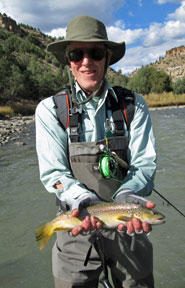
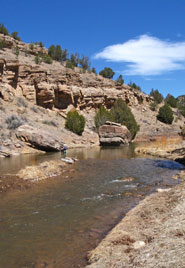
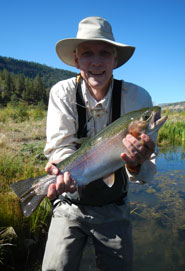
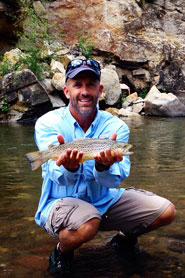
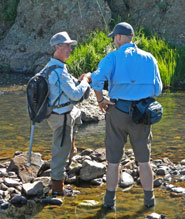
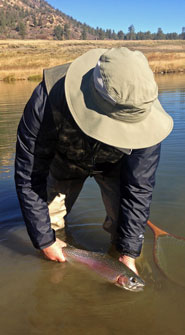
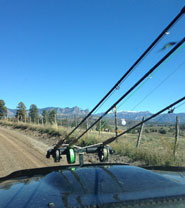
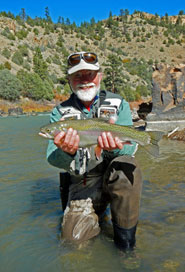


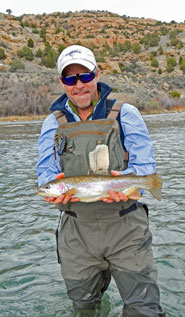

Fly Fishing Tips & Skills
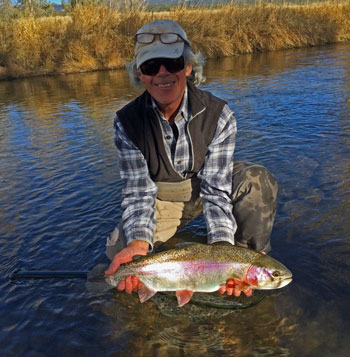
Though we primarily fish in Northern New Mexico and Southern Colorado, these fly fishing tips and skills can be applied on rivers, streams and lakes, anywhere in the world.
Below are some excerpts from the literature we use in the fly fishing classes we give. Hopefully you will find some things that will help to make fishing more fun and enjoyable! If you are on a guided trip with us and there is one particular skill you would like to work on our have us help you with, please don't hesitate to ask your guide about it.Note: We offer full day fly fishing and casting classes for individuals or groups. Please call or email us if you have any questions or would like us to do a class for you and/or your group. Classes can be done indoors or we can arrange to do them outside, on the water. Please check out the video "Los Alamos Fly Fishing Class - April, 2010" on our NM Fishing Videos Page.
Covering The Water:
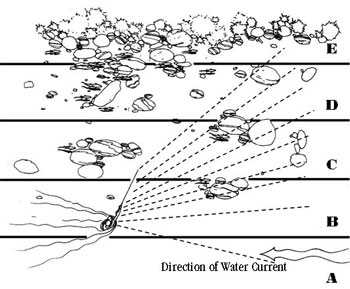
The All-Important Mend:
Getting your flies to drift naturally also known as "dead-drifting") your flies is crucial to getting fish to bite them. The most important way to accomplish this throughout the drift is to "mend" your line, often multiple times. A mend or "mending the line" is simply flipping a section of the line in between the rod tip and the indicator or dry fly so that it doesn't get caught in the current and create drag (as previously discussed, line drag will screw up your dead drift). The most typical mend will be to flip the middle or "belly" section of your line up-current (upstream) so that it won't get dragged below your indicator or dry fly. This is accomplished by flipping the line with your rod by moving it in a circular motion.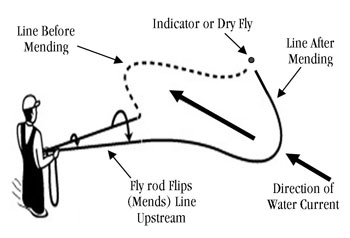

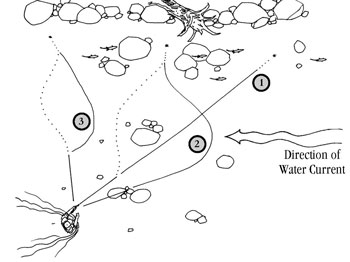
Here are a few "mending pointers" to keep in mind...
- Don't "over-mend"! Most people try to mend way too much line and with too much force. This usually leads to jerking your indicator and flies. You are better off to mend just enough line; more is not better with mending.
- It is always better to make multiple, smaller mends than to wait until the last minute and attempt to make one giant mend. Making multiple smaller mends will keep your drift more consistent and allow you to make subtle changes to it as needed, without interrupting the fishing.
- Try and pick a spot on your line (i.e. the junction of the fly line and the leader) to use as a target. Mend to this target and use it as a point where your mend stops on the line. This will help you to not over-mend. It will also help your accuracy and to not move your indicator or dry fly.
- In a spot where there is a strong current, you can consider throwing an upstream mend as soon as your fly line hits the water after a cast. This will help to get the drift started off correctly at the beginning.
- As you improve your mending skills, you can start to use your mends to help place your flies in specific areas of the stream/river that will hold fish. There are also many variations other methods of mending (i.e. the "Stack Mend") which you can learn and apply once you master the typical mend described in this article.
How to Set the Hook, Fight a Fish and Catch It:
So your flies are dead-drifting along perfectly under your strike indicator and you are watching it like a hawk. Here is (hopefully) what happens next. You notice that the indicator jerks ever so slightly. You set the hook and you have a nice fish on. You fight the fish until you can net it - well done! Let's go over the whole process of what just happened, step by step, detailing it as we go...1) Strike indicators maybe should be called "fish-on" indicators. What this means is that as soon as you see the indicator move, a fish has already taken any slack out of the leader and swum far enough to make the indicator jerk. So what this tells you is that: a) You always need to keep your eyes on the indicator or you will miss the strike, b) you need to set the hook immediately and c) you need to set the hook whenever the indicator moves, twitches or
even if it just stops
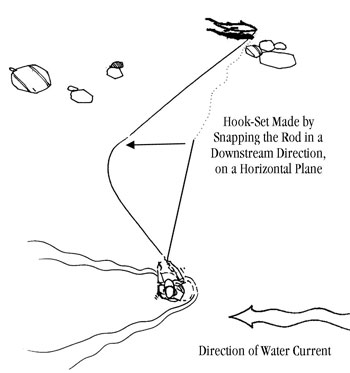
Try to remember to make the hook-set lightly. If you set too hard, you run the risk of pulling the flies out of the fishes mouth and, if you are using lighter tippet, you can break it instantly. Another benefit to setting lightly is that you won't yank your flies out of the drift, if you miss the fish, and they will still be fishing.
If you can learn to master this style of hook-setting, you will catch lots more fish. It take practice and it helps to try and stay relaxed and not over react. Needles to say, this is easier said than done. Note: All of the same general setting principles apply for dry fly fishing. The only real difference is that sometimes, when fish are feeding on the surface slowly, you don't want to make the hook-set as quickly as you would when fishing wet flies with an indicator.
3) Fighting a fish on a fly rod is pretty intuitive and how much pressure you apply and drag on the reel you use will change from fish to fish. As with any other type of rod and reel fishing, you need to keep a strain on the fish and the line taught at all times but you don't want to force things and break the tippet or pull the hook; a happy medium is required. The first thing you need to do is get any slack line you have out, back onto your reel. Don't try and fight the fish by just stripping in the line with your hands, you have a reel with a good drag - use it! Try and keep your rod in a vertical position with a bend in it. Let the fish take line off the reel when it wants and, as soon as it stops, start winding the line back in. You don't want to force the fish but don't let it just sit there either. Once again, there is a happy medium between the two.
4) After the fish has tired and you have got it close enough to get it in your net, lift your rod up and back. This will help to slide the fish into the net. One thing to watch out for at this point is that you don't wind too much line back onto the reel! If you do, you run the risk of getting the leader to flyline knot stuck in the guides and breaking off your fish. A good rule of thumb is to never wind the leader to flyline knot closer than 3 feet from the rod tip.
Keep Your Wading Gear Clean & Free of ANS:
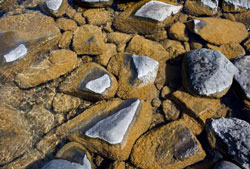
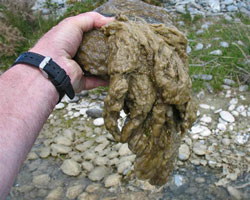
CLEAN: Soak and scrub all wading shoes and waders for at least 1 minute in a 2% by volume solution of household bleach or a 5% solution of salt. The cleaning solution should cover all surfaces of the gear that was exposed to the water you were fishing in. Water-absorbent equipment should be soaked to ensure that it is not infected. A soft brush is useful when cleaning the boot seams. If you chose to use a bleach solution to wash your gear, here are some easy formulas/ratios to mix up, which will give you a 2% solution:
Mix 1 and a 1/2 cups bleach with 5 gallons of water.
Mix 3 cups bleach with 10 gallons of water.
DRY: If you thoroughly clean and then completely dry all of your gear for at least 48 hours, even without using a salt or a bleach solution, your gear should be ANS free - but it needs to be completely dry! If fishermen take just a little extra time to perform these relatively simple tasks, they'll be doing their part to help prevent the spread of Aquatic Nuisance Species and "Hitchhiking Invaders". You can find more information on ANS and other methods to protect your gear at the website below:
Pictures Above: These images are of didymo algae (a.k.a. "Rock Snot") which can be devastating to the ecosystem of any river or stream.
The Best Methods of Catch and Release:

- When holding a fish, either for a picture or to look at it, always use both hands. Cradle the fish by cupping your hands under the forward part of the body and the tail. (Don't pick a fish up with one hand in the middle as you see in so many photos; it hurts the fish - especially larger ones picked up this way).
- Where applicable, use barbless hooks. An easily removed hook reduces the amount of fish handling. You can pinch the barbs down with a pair of pliers or hemostats.
- Try and land your fish as quickly as possible. The longer you play a fish, the more exhausted it becomes and the less likely it is to recover.
- Before handling a fish and/or taking it out of a net, wet both of your hands. This helps prevent the removal of a fish's protective slime.
- Don't squeeze the fish; don't put your fingers in its mouth, gills or on its eyes; don't grab its tail and lift it out of the water.
- Back the hook out carefully. If it helps or is needed, use a suitable tool such as forceps, pliers or de-hooking or catch and release tool.
- Try and keep the fish in the water at all times. If you want to take a photo of the fish out of the water, get everything set up, then lift the fish up and snap the photo quickly. Put the fish back in the water immediately after you take the picture. Try and limit the fish's time out of the water to less than 15 seconds.
- Don't let it flop around out of the water, on the ground or in the bottom of a boat. If possible, un-hook your fish and take any photos of it over or better yet, in the water - those pictures of a trout lying in the grass are not a good idea and very harmful to the fish.
- If the fish is hooked any deeper than the lips or in a part of the mouth where you can un-hook it easily, clip off the fly and let the fish go leaving the fly in it (the hook will rust out quickly).
- If a fish rolls over on its side or back, it's exhausted. You will need to take special care of it (see the next section).
- If your fish is exhausted and appears weak and overly tired, you will need to revive it. To revive a fish, grasp it gently in front of the tail and just behind the gills by cupping your hand underneath the belly. Move it gently back and forth so water works through its gills, providing it oxygen. Don't let go the first time the fish tries to swim away; let it go the second time, making sure it is revived. Try and do this in an area where there isn't much current. If need be, you can block the current with your upstream leg and revive your fish in the quiet water behind it.
- Don't dump a fish into fast water. It can start to tumble and not be able to get to a safe location where it can rest and breathe. Try and let it go gently in calmer water so it can swim away easily, at it's own pace and find some shelter.
Thank you in advance for releasing the fish you catch. We owe these fish quite a debt of gratitude for letting us catch them and providing us with such enjoyment. The least we can do in return is to release them correctly and try to guarantee their continued survival and health. The quote below says it all...
"The finest gift you can give to any fisherman is to put a good fish back, and who knows if the fish that you caught isn't someone else's gift to you?"
Lee Wulff
As with everything in fly fishing, all of these tips & skills will become second nature to you
with a little practice and experience. Just get out on the water, relax and have fun - that is what it is all about.



